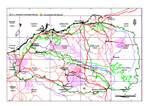Click on images
to enlarge


, BRM 4682, ORIGINAL SCAN, ADJUSTED RICHARD WOODMAN_sml.jpg)
Photographer: B.R. Maslin
, Bark 1, BRM 8567, ADJUSTED RICHARD WOODMAN_sml.jpg)
Photographer: B.R. Maslin
, Flowers 2, BRM 8567, ADJUSTED RICHARD WOODMAN_sml.jpg)
Photographer: B.R. Maslin
Botanical name
Acacia daweana Maslin, Nuytsia 4: 82, figs 5 & 11 (1982)
Common name
Dawe's Wattle
Description
Low-spreading or erect, often more or less flat-topped shrubs 0.3-1.5 m tall and 2-5 m across, dividing near ground level into few to many slender, spreading to erect stems. Bark grey but often curling near base of main stems in a semi-Minni Ritchi fashion to reveal a reddish or light brown undersurface, the outer layers peeling in thin, narrowly oblong, grey plates (some of which curl back on themselves slightly at either end). Branchlets invested with very short hairs or sometimes glabrous, yellow at apices but aging reddish brown. Stipules sub-persistent, small (1-2 mm long), dark brown. Phyllodes narrowly elliptic with the upper margin slightly more convex than the lower, 3-7 cm long, 6-14 mm wide, rather spreading, straight or (especially near apex) shallowly recurved, glabrous or sub-glabrous (with hairs as on branchlets), dull to bright green; parallel longitudinal nerves numerous with a few longitudinal anastomoses in between, nerves fine with the central one (and usually one on either side of it) more evident than the rest; narrowed at apex into an acute, rather hard (but not spiny) point, infrequently obtuse. Inflorescences simple; peduncles 5-10 mm long, indumentum as on branchlets; spikes 25-40 mm long and about 10 mm wide when fresh, bright golden, the flowers close together. Flowers 5-merous; calyx shortly divided. Pods (few seen, immature) raised over seeds and constricted between them, 20-40 mm long, 5-7 mm wide, coriaceous, slightly viscid, curved, obscurely reticulately veined, sparsely hairy; margins thickened and yellowish. Seeds (immature, few seen) oblique in the pods, ±ellipsoid, 3 mm long, not shiny, light brown.
Characteristic features
Low, spreading shrubs. Bark grey but peeling in a more or less Minni Ritchi fashion at base of stems. Stipules sub-persistent, small (1-2 mm long). Phyllodes narrowly elliptic, rather short and broad (3-7 cm x 6-14 mm), apices often acute and shallowly recurved, finely multi-nerved and sparingly reticulate. Spikes long (25-40 mm). Peduncles comparatively short (5-10 mm). Shy seeder.
Distribution and ecology
Known only from the Pilbara region of northwest W.A. where it has a restricted distribution, in the Hamersley Range and mostly within the Karajini National Park (known from just four general localities over a distance of about 180 km). Despite numerous recent surveys in the Hamersley Ranges no new populations of this species have been found. Grows on rocky red skeletal loam in spinifex on lower scree slopes and bajada outwash fans of rocky banded ironstone ranges and ridges (often along diffuse but well incised drainage lines). Acacia daweana is typically killed by fire however in one population plants have the ability to regenerate advantageously from a rootstock.
Flowering and fruiting period
Because of the paucity of collections it is difficult to accurately determine the flowering and fruiting phenology of this species. However, based on existing material it flowers from June to August. Despite prolific flowering A. daweana appears to produce very few pods (collected in September and October).
Taxonomy
Based on field and morphological evidence it seems likely that this species represents a hybrid involving A. effusa and A. hamersleyensis in at least three of the known populations. The main factors supporting this notion are: the bark of A. daweana appears to be intermediate between the red Minni Ritchi of A. effusa and the grey non-Minni Ritchi of A. hamersleyensis , and both putative parents were present in the populations where A. daweana was found. In the remaining population A. effusa was present with A. tumida var. pilbarensis, but A. hamersleyensis was absent. In all four populations A. daweana was not common, and negligible or nil fruit was set by these plants despite their prolific flowering.
Conservation status
Acacia daweana is currently classified as a Priority 3 species on the Department of Environment and Conservation's Declared Rare and Priority Flora List. Such a conservation status is warranted in response to the increasing threat posed by changes in fire regime in the Hamersley Range, particularly fire frequency. Outside Karijini National Park some plants and entire populations may also be threatened by exploration and potential mining activity as the bajada outwash fans on which some populations grow may harbor substantial deposits of detrital iron ore.
Origin of name
This species is named for Mr Chris Dawe in appreciate of the help he provided to the first author at the time of preparing the description of this plant.
